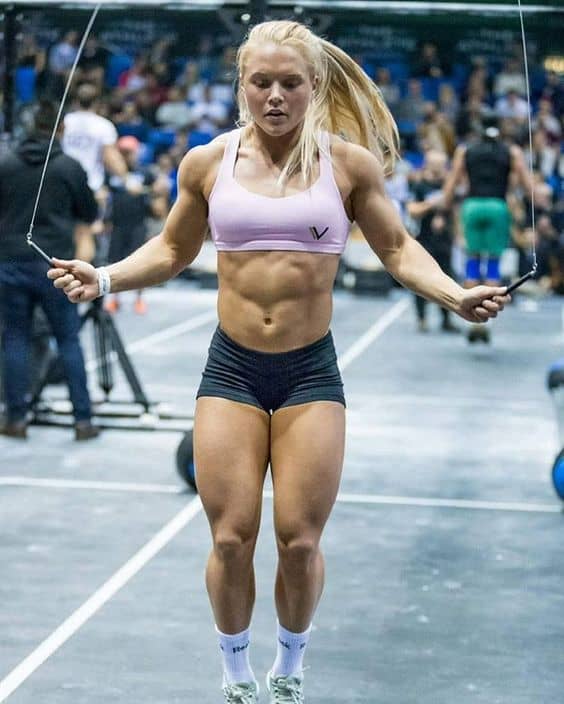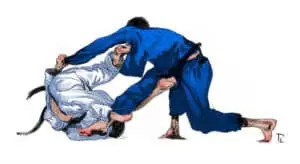
BJJ athletes are always looking for ways to increase their cardio and strength on the mats. Who doesn’t want the ability to spar at full speed for hours and hours while using your soul crushing strength to submit opponents at will?
However, the best forms of physical preparation for BJJ are a topic of debate. It is time to determine if crossfit can help BJJ athletes improve their performance.
Is Crossfit Good For BJJ?
Crossfit is not good for BJJ because the sport is too intense leading to fatigue and placing BJJ athletes at risk of injury. Many of the exercises in crossfit have little cross over to BJJ. BJJ athletes are better off increasing their BJJ training volume and training for speed and strength separately.

Crossfit Places BJJ Athletes At Risk Of Fatigue And Injury
BJJ is already an intense sport that places athletes at substantial risk of injury. Research has shown 90% of BJJ athletes who have trained for over 1 year have suffered an injury. The last thing BJJ athletes need to do is compound their chance of injury by training in Crossfit.
Crossfit currently has an injury rate of 3.24 per 1000 hours of training. You are actually safer training full contact rugby which has a training injury rate of 2.8 per 1000 hours than practicing Crossfit.
Crossfit athletes aren’t just suffering minor injuries. The most common injuries include sprains, tears and herniated discs to the shoulder, lower back and knees. These areas of the body are also placed under a tremendous strain when training BJJ with many athletes suffering similar injuries.
If you thought BJJ jacked up your back, knees and shoulders you will really feel like you have been hit by a truck once you start adding Crossfit sessions to your training routine.
Crossfit is just too dangerous for BJJ athletes to train in. General training should be safe and improve performance on the BJJ mats but Crossfit’s high injury rate actually risks hurting athletes’ on mat performance by damaging the body.
Crossfit Exercises Don’t Translate To BJJ

Crossfit is heavily focused on weightlifting movements such as snatch, clean and jerk, push press and overhead squat. The BJJ performance increase you are going to experience from practicing these movements is minimal. More than likely you are just going to fatigue yourself and end up stiff and sore on the BJJ mats.
Russian wrestlers do little to no weightlifting. They certainly do not lack speed and power on the wrestling mat.
Crossfit also incorporates a lot of gymnastic movements. Many of these gymnastic movements particularly exercises such as handstand push ups and ring routines are heavily skill based and take a lot of practice to perfect.
These exercises have little to no correlation to BJJ performance and are a waste of time for Jiu Jitsu athletes to practice.
Crossfit does have some exercises which are beneficial to BJJ athletes but these should not be performed in a cardio circuit workout but rather in a strength or speed training manner where the athlete can rest between sets.
The most effective crossfit exercises for BJJ athletes include rope climbs, pull ups, box jumps, handstand walks and push ups.
Crossfit’s Methodology Of Training Speed And Strength Together Is Ineffective For BJJ

A big problem with Crossfit training is that speed and strength exercises are trained alongside each other with little to no rest. The result is deficient training of both athletic qualities.
BJJ athletes should train speed and strength separately and athletes should fully recover between each set.
For example instead of BJJ athletes doing deadlifts and then immediately performing box jumps.
The box jumps should be performed on a separate day to the deadlifts and between each set athletes should rest 2 to 3 minutes.
This is extremely important when training speed. If you are not moving your body close to your 100% maximum speed then you are not actually improving your speed. To move at maximal speed you need to be fully rested between sets.
With Crossfit style training athletes often work at sub maximal speed and strength levels resulting in athletes failing to improve either of these metrics.
BJJ Athletes Are Better Off Focusing On Specific Training

Most BJJ athletes would increase their Jiu Jitsu performance by simply spending more time training BJJ. If you are spending less than 10 to 12 hours a week on the mat then do not worry about non BJJ training.
Specific training is almost always going to be more effective at developing an athlete than general training.
This is particularly true in a sport like BJJ where technical mastery is so important and where there are thousands of techniques that athletes need to wrap their heads around.
Many BJJ athletes started training Jiu Jitsu when they were already adults after previously playing other sports. These athletes in particular would not benefit from Crossfit or other general training, as they have spent years training generally and now need to focus on highly specific training to improve their BJJ skills.
Soviet sport’s scientists determined the best way to develop an athlete was to take a 5 year old child, train them for years in general athletic training, then when they are 10 start introducing them to their specialised sport.
Then from the age of 10 to 14 slowly decrease general training and increase specific training. Then from the age of 15 train the child full time in their specialised sport.
A BJJ athlete who started training as an adult should only be focusing on specialised training as by spending their formative playing other sports they have actually overdosed on general training. To catch up they need pure focus on BJJ training.
Specific training is also the best way to develop the specific athletic qualities you need for your sport. Doing hill sprints, swimming laps in the pool or cycling everywhere is not just as effective at building cardio for BJJ as sparring at a high intensity.
Likewise BJJ mat strength is not the same as gym strength and is best developed performing BJJ movements.
One of the strongest BJJ athletes I know did no weightlifting training and I personally saw him struggle to deadlift 220 pounds. He however had ridiculously strong grips, crazy strong squeezing ability and a bridge that was able to shake loose even the heaviest black belt.
